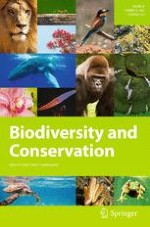15-06-2017 | Letter to the Editor
Passive acoustic monitoring as a complementary strategy to assess biodiversity in the Brazilian Amazonia
Published in: Biodiversity and Conservation | Issue 12/2017
Log inActivate our intelligent search to find suitable subject content or patents.
Select sections of text to find matching patents with Artificial Intelligence. powered by
Select sections of text to find additional relevant content using AI-assisted search. powered by
